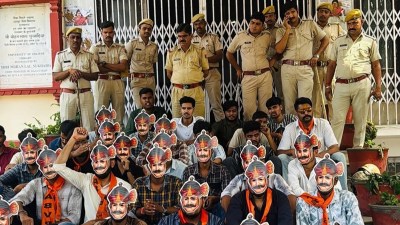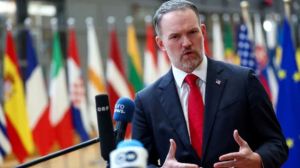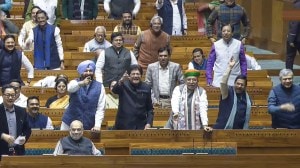
QUESTION 1
With reference to the di-ammonium phosphate (DAP), consider the following statements:
1. It is a critical fertiliser containing phosphorus (P) nutrient that crops require during the early stages of root and shoot development.
2. DAP is India’s most-consumed fertiliser.
3. DAP contains 18 per cent phosphorus (P) and 82 per cent nitrogen (N).
How many of the statements given above are correct?
(a) Only one
(b) Only two
(c) All three
(d) None
Explanation
— China’s unpredictable export limits do not only apply to rare earth elements and magnets used in electric vehicles (EV), wind turbines, defence equipment, and different consumer electrical products. There are also issues with the availability of di-ammonium phosphate (DAP), a crucial fertiliser containing the phosphorous (P) ingredient that crops require during the early stages of root and shoot growth. Farmers frequently mix it in with the seeds when they sow them. Hence, statement 1 is correct.
— DAP is India’s second most consumed fertiliser, with an average annual sales volume of 103.4 lt over the last five years, trailing only urea (359 lt). A considerable portion of that, an average of 57 litres during this period, is imported in finished form. Hence, statement 2 is not correct.
Story continues below this ad
— According to the accompanying data, China was a major, if not the leading, supplier of DAP to India until 2023-24 (April-March). However, imports from China decreased from 22.9 lt in 2023-24 to 8.4 lt in 2024-25. Since the beginning of the current calendar year, not a single tonne of Chinese goods has entered the country.
— DAP includes 46% phosphorus (P) and 18% nitrogen. Many industry professionals and agronomists feel that Indian farmers should be prevented from using fertilisers with extremely high individual nutrient content, such as DAP or urea (46% N) and muriate of potash (60% potassium or K). Hence, statement 3 is not correct.
Therefore, option (a) is the correct answer.
QUESTION 2
With reference to the new Motor Vehicle Aggregator Guidelines, 2025, consider the following statements:
1. The aggregator shall be permitted to charge a minimum of 50% lower than the base fare and a maximum dynamic pricing of two times the base fare.
Story continues below this ad
2. Base fares are notified by the central government for the corresponding category of motor vehicles.
Which of the statements given above is/are correct?
(a) 1 only
(b) 2 only
(c) Both 1 and 2
(d) Neither 1 nor 2
Explanation
— The Ministry of Road Transport and Highways (MoRTH) declared on July 1 that cab aggregators like Uber, Ola, and Rapido can now charge consumers up to twice the base cost as the maximum fare. The new Motor Vehicle Aggregator Guidelines, 2025, increased the previous restriction to 1.5 times the base fare.
— “The aggregator shall be permitted to charge a minimum of 50% lower than the base fare and a maximum dynamic pricing of two times the base fare…,” according to the guidelines. The state governments notify the public about the base fares for the respective motor vehicle type. States are advised to apply the amended rules within three months. Hence, statement 1 is correct and statement 2 is not correct.
Therefore, option (a) is the correct answer.
QUESTION 3
With reference to the Solar Energy Corporation of India (SECI), consider the following statements:
Story continues below this ad
1. It is the Maharatna CPSU dedicated to the growth and development of Renewable Energy (RE) capacity in India.
2. It acts as a nodal agency to enable meeting the growing energy demand through RE and reducing the dependence on fossil fuels.
Which of the statements given above is/are correct?
(a) 1 only
(b) 2 only
(c) Both 1 and 2
(d) Neither 1 nor 2
Explanation
— Solar Energy Corporation of India Limited is India’s leading Navratna CPSU focused on the expansion and development of renewable energy (RE) capacity. Hence, statement 1 is not correct.
— To achieve India’s lofty RE ambitions, the Government of India selected SECI as a central body to satisfy rising energy demand through RE while lowering reliance on fossil fuels. Hence, statement 2 is correct.
Story continues below this ad
— Models such as solar-wind hybrid with/without energy storage, Round-the-Clock (RTC) power supply, RE with assured peak power supply, Firm and Dispatchable RE (FDRE), and others have significantly boosted the growth of the RE market and created a thriving RE ecosystem, while optimising RE uptake across various states in response to the sector’s changing landscape.
Therefore, option (b) is the correct answer.
(Source: http://www.seci.co.in)
QUESTION 4
With reference to the National Statistics Day, consider the following statements:
1. June 19 is celebrated as National Statistics Day.
2. It is the birth anniversary of Prasanta Chandra Mahalanobis, the father of statistics in India.
Which of the statements given above is/are correct?
(a) 1 only
(b) 2 only
(c) Both 1 and 2
(d) Neither 1 nor 2
Explanation
— June 29 is celebrated as National Statistics Day. It is the birth anniversary of Prasanta Chandra Mahalanobis, the father of statistics in India. Hence, statement 1 is not correct and statement 2 is correct.
Story continues below this ad
— Mahalanobis, often known as ‘The Professor’, was instrumental in establishing the Indian Statistical Institute (ISI) in Kolkata as well as the Planning Commissions of independent India. Among his many gifts, India benefited the most from his ability to precisely and effectively comprehend the stories contained in datasets.
— Born in Kolkata in 1893 to an aristocratic Brahmo Samaj family, Mahalanobis attended Presidency College before moving to London for further study. However, he returned to India and dedicated his life to both establishing statistics as an academic field and applying academic knowledge to real-world problems.
Therefore, option (b) is the correct answer.
QUESTION 5
The Reserve Bank of India has issued directions that certain categories of banks will not levy any pre-payment charges for all loans granted for business purposes to individuals and small businesses. Which of the following categories are excluded?
1. Commercial banks
2. Regional rural banks
3. Local area banks
4. Tier 4 primary (urban) co-operative bank
Select the correct answer using the codes given below:
(a) 1 and 2 only
(b) 2 and 3 only
(c) 3 and 4 only
(d) 1 and 4 only
Explanation
— The Reserve Bank of India (RBI) has prohibited banks, certain non-bank financing firms (NBFCs), and a few other lenders from imposing foreclosure or prepayment penalties on floating-rate loans made to micro and small businesses (MSEs). The banking regulator also urged all regulated entities (RE) not to impose prepayment penalties on floating-rate personal loans. The new laws will apply to any loans sanctioned or renewed after January 1, 2026.
Story continues below this ad
— The Reserve Bank of India has issued directions that commercial banks, tier 4 primary (urban) co-operative bank, non-banking financial companies-upper layer (NBFC-UL), and All India Financial Institutions will not levy any pre-payment charges for all loans granted for business purpose to individuals and small businesses.
— However, small finance banks, regional rural banks (RRBs) and local area banks have been excluded from the new norms.
Therefore, option (b) is the correct answer.
QUESTION 6
Consider the following statements:
1. The World Bank under the Extended Fund Facility (EFF) provides financial assistance to countries facing serious medium-term balance of payments problems because of structural weaknesses that require time to address.
2. The International Bank for Reconstruction and Development (IBRD) as the largest development bank in the world, provides loans, guarantees, risk management products, and advisory services to middle-income and creditworthy low-income countries.
Which of the statements given above is/are true?
(a) 1 only
(b) 2 only
(c) Both 1 and 2
(d) Neither 1 nor 2
Explanation
Story continues below this ad
— According to the IMF, the Extended Fund Facility (EFF) “provides financial assistance to countries facing serious medium-term balance of payments problems because of structural weaknesses that require time to address”.
— Put simply, the IMF provides assistance under the EFF to countries that do not have enough money to pay their bills to the rest of the world for the goods and services they import.
— “ The International Bank for Reconstruction and Development (IBRD) is a global development cooperative owned by 189 member countries. As the largest development bank in the world, it supports the World Bank Group’s mission by providing loans, guarantees, risk management products, and advisory services to middle-income and creditworthy low-income countries, as well as by coordinating responses to regional and global challenges.”
Therefore, option (b) is the correct answer
QUESTION 7
With reference to ‘e-way bill’ system, consider the following statements:
1. It is for GST registered person / enrolled transporter for generating the way bill electronically on commencement of movement of goods.
2. The goods included should exceed the value of Rs. 50,000 in relation to supply or for reasons other than supply or due to inward supply from an unregistered person.
Which of the statements given above is/are correct?
(a) 1 only
(b) 2 only
(c) Both 1 and 2
(d) Neither 1 nor 2
Explanation
According to ewaybillgst.gov.in,
— “E-Way bill system is for GST registered person / enrolled transporter for generating the way bill (a document to be carried by the person in charge of conveyance) electronically on commencement of movement of goods exceeding the value of Rs. 50,000 in relation to supply or for reasons other than supply or due to inward supply from an unregistered person.”
Therefore, option (c) is the correct answer.
(Also refer: E-way bill: An electronic system to track goods movement, a way to plug leaks under the GST framework by Anchal Magazine)
QUESTION 8
With reference to RBI as ‘Banker to Government’, consider the following statements:
1. RBI has the obligation to undertake the receipts and payments of the Central Government and to carry out the exchange, remittance and other banking operations, including the management of the public debt of the Union.
2. State Government transactions are carried out by RBI in terms of the Finance Commission recommendation every five years.
Which of the statements given above is/are correct?
(a) 1 only
(b) 2 only
(c) Both 1 and 2
(d) Neither 1 nor 2
Explanation
According to FAQs on rbi.org.in:
What is RBI’s role with regard to conduct of the Government’s banking transaction?
— “In terms of Section 20 of the RBI Act 1934, RBI has the obligation to undertake the receipts and payments of the Central Government and to carry out the exchange, remittance and other banking operations, including the management of the public debt of the Union. Further, as per Section 21 of the said Act, RBI has the right to transact Government business of the Union in India.
— State Government transactions are carried out by RBI in terms of the agreement entered into with the State Governments in terms of section 21 A of the Act. As of now, such agreements exist between RBI and all the State Governments except Government of Sikkim. Thus, the legal provisions vest the Reserve Bank of India with both the right and obligation to function as bankers to the government.”
Therefore, option (a) is the correct answer.
Previous Daily Subject-Wise-Quiz
Daily Subject-wise quiz — History, Culture, and Social Issues (Week 115)
Daily subject-wise quiz — Polity and Governance (Week 117)
Daily subject-wise quiz — Science and Technology (Week 117)
Daily subject-wise quiz — Economy (Week 116)
Daily subject-wise quiz — Environment and Geography (Week 116)
Daily subject-wise quiz – International Relations (Week 116)
Subscribe to our UPSC newsletter and stay updated with the news cues from the past week.
Stay updated with the latest UPSC articles by joining our Telegram channel – IndianExpress UPSC Hub, and follow us on Instagram and X.


































